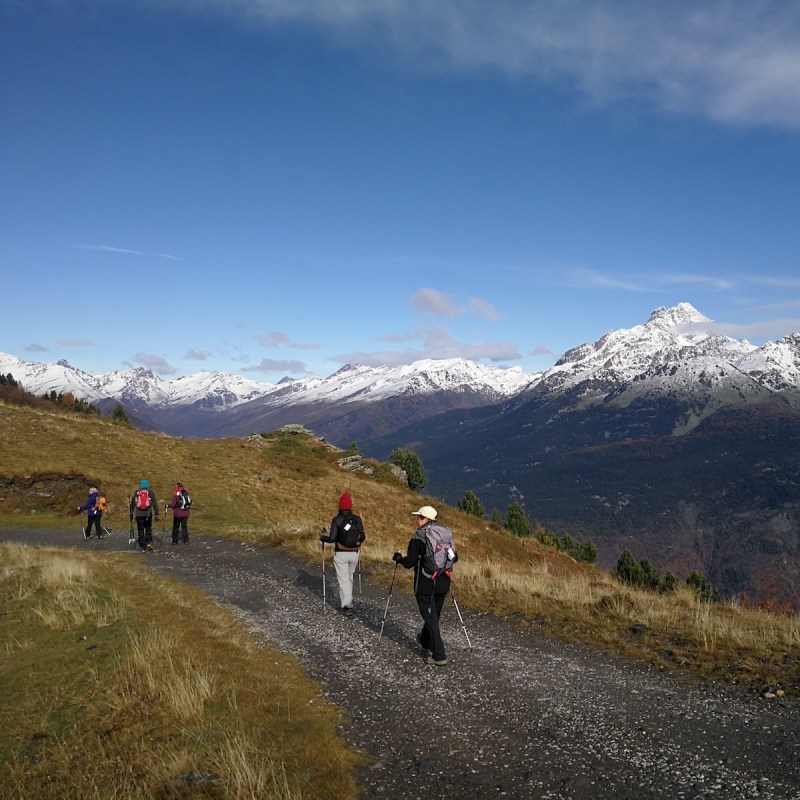
Hiking has always played a huge role in my adult life. The passion started in the mountains of Mexico and the South American Andes and has carried me across continents and through a mixed bag of diverse terrains. Nowadays, I spend just under half of my year in the state of Victoria in Australia, where my hikes take me close to the ocean, into the Victorian Alps, and through some of the wonderful gold rush towns around Beechworth. But it’s the varied landscapes of Europe, and specifically Italy and its neighbors, that completely hold me in their thrall, both as a professional guide and as an independent hiker.
Videos by TravelAwaits
So what exactly is the attraction of hiking in Europe? Doesn’t traveling by car, bus, or train allow you to cover more ground? The simple fact is that when you hike, you get to see things you’d never see from behind the windows of a vehicle. When you can feel the ground beneath your feet, you really experience a region. Your senses come alive with the scent of plants and wildflowers, the sound of gurgling streams and birdsong, and, of course, a range of magnificent vistas. By walking across hills and through valleys and remote villages, you can get to know a region through its culture and history, all the time working up an appetite to indulge in some delicious local gastronomy.

1. Europe’s Varied Landscape
Leaving aside Europe’s gastronomic offerings for a moment, let’s think about its geography. If you’re after variety, you couldn’t be better placed than in Europe. In Italy alone, landscapes range from rugged mountains, Alpine lakes, and glacier-carved valleys to wide coastal plains. Mixed up somewhere in between, you’ll find volcanoes, the gently rolling hills and valleys of Tuscany, and, in the Abruzzo, something close to a wilderness area that is home to wild boars, wolves, and bears.
Meanwhile, venture across Italy’s borders into its neighbors — France, Austria, Switzerland, and Slovenia — and the landscape shifts further. In these countries, you can feast your eyes on lavender fields in Provence, craggy mountain peaks in Switzerland, and crystal-clear, turquoise lakes in Slovenia’s Julian Alps.
You’ll also find all this variety packed into relatively small areas. Take the French island of Corsica, which is just over 100 miles from tip to tip. This stunning island is blessed with green forests, mountain ranges that plunge into the sea, and torrents and waterfalls that have carved out gorges and valleys, while its coastline features crystalline water and spectacular natural marine parks.

2. Cultural Differences Across Europe’s Borders
I love the changes in landscape you encounter when you cross European borders. Of course, there’s nothing to stop you from driving, but I still find it thrilling to walk from one country to another! And it’s not just the landscape that changes. Shaped by history and tradition, these border regions are fascinating for so many reasons, with elements of both countries manifesting themselves in the food, language, and in people’s characters.
One of the highlights of my tour in Austria and the Dolomites, apart from the breathtaking alpine hiking and views, is the opportunity to experience the fascinating Tyrolean culture. In this patch of Europe that extends between Italy and Austria, wooden chalets, scarlet geranium–filled window boxes, and unique cuisine — think tortelloni followed by apple strudel — are very much part of the attraction. The region also has its own language, Ladino, although you’ll find Italian and German spoken in most towns.
The region is a big wine-growing area, but head into Bolzano, the capital city of South Tyrol, and you’ll find beer gardens alongside wine bars in the cobblestone streets.

3. Taste Local Produce
Food is an increasingly important part of a holiday for most of us. While there was a time when people were reluctant to try “foreign” food, nowadays experiencing a different cuisine is all part of the enjoyment. However, when you dine out in a big city, it can fall rather short of the mark. Head into the countryside where food is locally sourced and seasonal, and you’ll get the opportunity to try recipes that have been handed down through generations, prepared with the freshest local ingredients.
Not surprisingly, getting out into the countryside, walking through vineyards and olive groves, also immediately connects you with the gastronomic landscape. After all, what could be more blissful than a picnic packed with simple, fresh ingredients that more than deliver on the flavor front?
So, what are the top hiking regions that best deliver on flavor? For a really exceptional gastronomic experience, hiking in the foodie-friendly Italian region of Piedmont, the birthplace of the “Slow Food” movement, is a good place to start. By all means, take time to appreciate the rugged peaks and waterfalls, but don’t miss the chance to picnic in the summer with artisan-produced cheeses and juicy bowls of cherries and peaches.
Autumn is also a wonderful time to walk in Piedmont, a time to enjoy views across hillsides ablaze with burnished golden and amber leaves, and hearty dinners featuring chestnut and truffle-inspired dishes.

4. Wine-Tasting Experiences While You Hike
Wine tasting and hiking may sound like an odd combination, but it’s an excellent option for couples with an interest in wine who enjoy active holidays. Join a walking tour or plan a route that incorporates a wine-tasting experience, and you’ll get even more out of your hike.
Including a winery visit is also a good option for first-time hikers looking for a more laid-back experience. While I love challenging hikes in an alpine setting, I’m equally comfortable taking it slowly across the terrain. This allows me to enjoy the view and linger in villages along the way. In Tuscany, for example, where I live part of the year, pausing to chat with local winemakers about their wines and olive oils is a definite highlight.

5. Europe’s Art Treasures
Personally, the best way to appreciate some of Europe’s incredible art riches is to experience them just a little bit at a time. Yes, a weekend filled with Parisian art galleries or Florentine Renaissance masterpieces is on most of our wish lists, but I find that slipping viewings of artistic treasures into a European hiking holiday can be equally, if not more, satisfying.
Firstly, sometimes we just need time to absorb the true splendor of what we’re seeing, so after a half day of art-filled wonder, the law of diminishing returns kicks in. For me, a one-day visit to the UNESCO World Heritage mosaics and monuments in Ravenna is the perfect finale to a week’s hiking in Northern Italy; but adding a second day of art appreciation would be rather like eating two desserts! We sometimes just need time to absorb what we’ve seen before embarking on another round of masterpieces.
Secondly, while Europe’s big-hitting art and architecture — say, Florence’s Duomo or the Louvre in Paris — is quite simply magnificent, there’s also something magical about discovering lesser-known sights. Explore on foot, and you’ll pass pretty rural chapels and 15th-century frescoed churches in beautifully preserved hideaway villages that you’d be unlikely to stumble upon if you were traveling by car or train.
I also love hiking on routes that provide preview glimpses of a town or village. For example, in Tuscany, one of my favorite walks leads down through woods with views across to the iconic towers of San Gimignano.

6. Walk Through History
Last, but certainly not least, a hiking holiday in Europe is such a great way of walking through history. Europe has the most incredible wealth of churches, museums, and monuments that, apart from being aesthetically pleasing, provide a wonderful overview of history. They fill the gaps, helping us work out what fits in where and when. Nevertheless, visiting these treasures is a very different learning experience when walking through a landscape or village.
So, what sort of things can you expect to find when you hike? Well, I’ve walked past ancient tombs on sunken Etruscan roads and hiked part of the Via Francigena pilgrim route through beech and chestnut woods in central Italy. Further west, in the alpine region between France and Italy, you can follow the ancient route of Roman armies, walk through valleys carved out by glaciers millions of years ago, and hike along the route used by Victor Emmanuel II, the first King of Italy, in the 19th century.
Meanwhile, in Slovenia, a hike through the narrow gorge that leads to the Franja Partisan Hospital is significantly enriched by its history. The hospital, buried deep within the Pasice Gorge, treated partisan soldiers from the former Yugoslavia and other countries during World War II and, even today, is a true testament to the heroism and humanity of the Slovene people.
Similarly in the nearby hills behind Kobarid, you can step back in time on the route past the remains of an ancient fort and past trenches that witnessed the World War I battles on the Isonzo front.
If you’re planning a trip to Europe, or simply want to hike in this incomparable part of the world one day, these are great resources:

